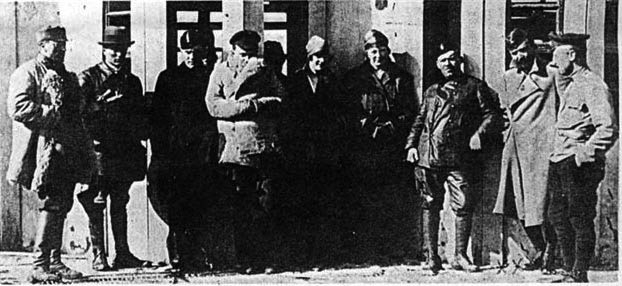The history of the struggle for independence of Ukraine has a lot of good and bad pages. In 1918, the first time in two hundred years, Ukrainians could create their own state - Ukrainian People's Republic (UPR). But, from the first days of its existence, thousands of patriots had to defend the sovereignty of the Russian Bolshevik attacks. In this fight Ukrainians and Muslims from the former Russian Empire were standing side by side.
The first national formation of UPR army was the 3d Muslim Battalion of the 205th Shelahinsk regiment, which was a part of the 3d Caucasian Corps, consisting of Bashkirs and Tatars from Kazan. In February 1918, they were going back from the south-western front to Kazan, and near Kamianets-Podilskyi they collided with Bolsheviks, who were planning to take over the control of Podil province. During the successful fight, the Muslim battalion, consisting of 400 soldiers (56 of whom have been lost), took the ferry across the River Smotrych and the bridge over the River Dniester. This allowed the Ukrainian soldiers turned out the Russian troops of Kamianets-Podilskyi.
The successful military cooperation had led to the fact that on March 7, 1918 the Muslim battalion was included among the army of UPR. Later, it took an active part in the liberation of the Left-Bank Ukraine from the Russian Bolshevik army. After Hetman Skoropadsky had taken the power in the late April, 1918 the battalion, together with a number of other units of UPR’s army, were disbanded, and its soldiers returned to their homeland.
Another one episode of the joint struggle of Ukrainians and Muslims occurred in April 1918, when the troops of UPR came to the borders of Crimea, which was occupied with RSFSR army. On April 22, in Symferopol a secret meeting of the representatives of the Ukrainian army and the Crimean Tatar kurultai was held, during which they decided to liberate Crimea with UPR forces from the Russian occupation troops.
Colonel Petro Bolbochan led the Crimean group of UPR Army. On April 23, the Ukrainian troops occupied Dzhankoy, after that, two Muslim military units: the chambul of the Tatar cavalry and the squadron of the Turkish infantry joined them. The Tatar chambul consisted of several hundred Crimean Tatar warriors, who knew the area very well and served as the guides for Bolbochan’s troops. The Turkish squadron was formed from army prisoners of the Ottoman army, who were captured during the First World War. The squadron included for about 200 soldiers.
On April 24, The Ukrainian and Muslim forces captured the capital of Crimea - Bakhchisarai. Due to successful joint operations, almost the whole peninsula was liberated from the forces of Communist Russia by the end of April.
Afterwards, a lot of Muslims, including Crimean Tatars, were fighting among the Ukrainian army. Thus, an outstanding military leader, Colonel Dzhambulat Kanukov fought in the in the ranks of the Ukrainian Halician Army (UHA) in the capacity of commander of air group of UHA. The Nationality and the exact place of birth of Kanukov are unknown. Ukrainian general Omelyanovich-Pavlenko M. calls him Tatarian in his memoires, but, according to the other sources, he was Kabardian or Ossetian.
Before World War I, Kanukov served in the 7th hussar regiment. In 1915, he moved to the 17th aviation detachment. After graduating from flight school, he became a fighter pilot. Dzhambulat Kanukov and his brother Khasbulat took service to the Ukrainian army in 1918. At the end of 1918, Dzhambulat became a commander of the 2nd aviation division of the Podilsk corps, which was sent to help the Ukrainian Halician Army (UHA), while the second one conducted bloody battles against the Poland forces. Dzhambulat Kanukov, due to his great war experience, became the best military pilot of UHA. He had been shooting down 9 of the Polish aircraft for few months.
In March 1919, Kanukov was appointed commander of aviation of UHA. According to the eyewitnesses who served together with the heroic pilot, he was an excellent organizer and an innovator who succeeded in modernization of the obsolete aircraft fleet, by installation of more powerful engines into the aircrafts. The Kanukov brothers died defending the independent of Ukraine (Khasbulat in February and Dzhambulat in May, 1919).
Lieutenant colonel Ali Bey Balatukov, Crimean Tatarian by origin, served with the army of the UPR. It is known, that he was born in Kerch in 1885. He fought in the ranks of the Russian army during the First World War. In 1920, Balatukov was an officer in the renowned 6th Legion of Ukrainian Sich Riflemen of the UPR army, which stopped the attack of the Bolshevist forces during the bitter fighting of Zamosc. This battle played a big part for the victory over the forces of Soviet Russia in the battle of the Vistula River.
After the ending of the hostilities in November 1920, Ali Bey Balatukov had been serving as an officer in the Department of the military logistics of the 6th Sich division for three years. There is no information about his afterlife.
For a good while, the contribution of Muslims to the struggle for independence of Ukraine wasn’t being evaluated properly. The historians are only just beginning to open new pages of the heroic past of our country.
You can find the other materials about "The history of Islam in Ukraine" by clicking the following reference.
Alexander Stepanchenko,
specially for "Islam in Ukraine"




